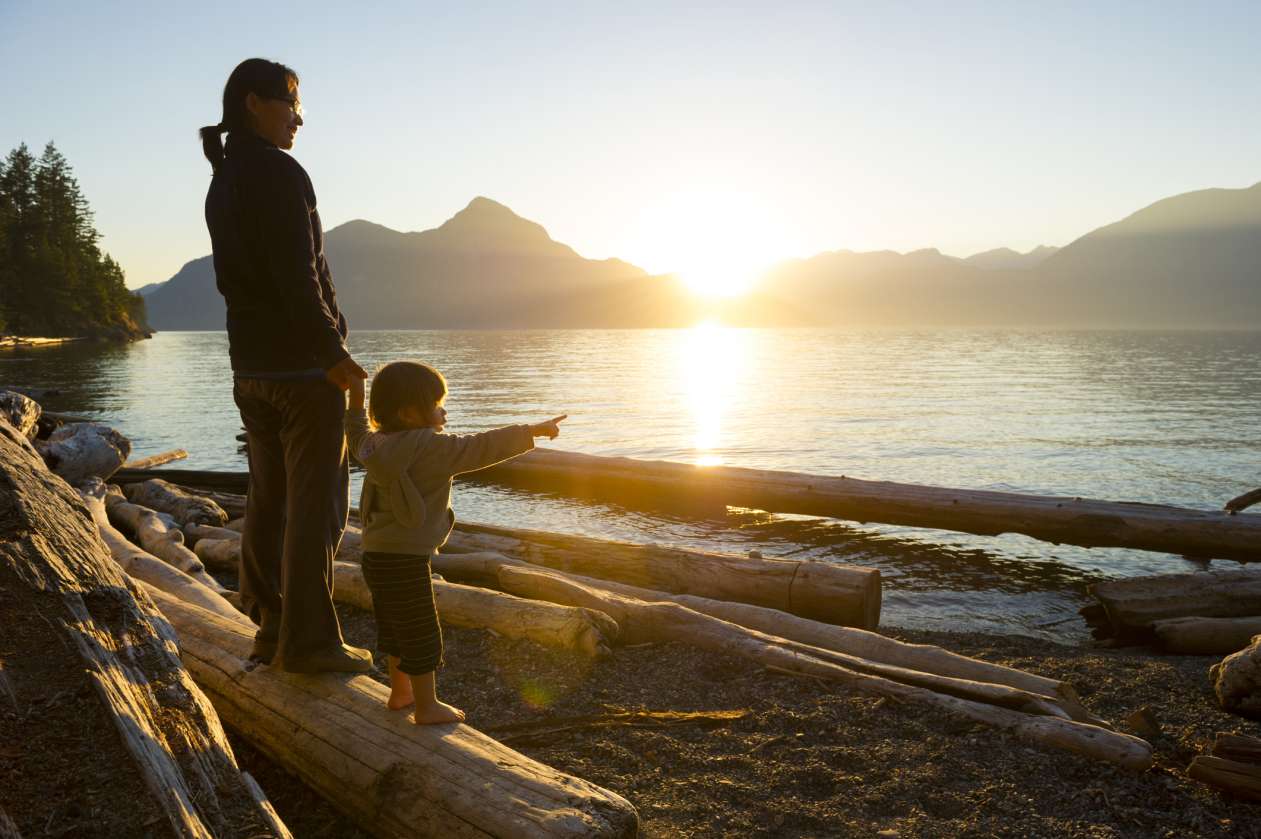
How to adapt the activities you enjoy as an adult for toddlers
Before you had a baby, you may have thought that you weren’t going to stop your life at all—that you’d be all laissez-faire and have them adapt to your lifestyle, not the other way around. While this certainly isn’t a bad way to approach parenthood—after all, it’s important to hold onto yourself—it’s not always realistic for everyone once the baby comes around.
Sleep struggles, temper tantrums, picky eating, and physical mobility may all get in the way of doing the things you once loved pre-having kids. And, when you try to do those activities anyway, the harsh realization that it’s “just not the same” may make you opt to sit these activities out until your kids are older (or out of the house altogether).
It’s not just about calling a babysitter so you can go out and enjoy it (which is totally okay). It’s about wanting to actually do these things with your toddler, especially if they’re a huge part of your life and who you are. So how can you make activities you love as an adult fun for your young children—and, of course, fun for you?
Here are some tips:
How to introduce your toddler to your hobbies
Introducing your toddler to what you love to do of course depends on your child, their preferences, and where they are developmentally. It also may mean investing in gear, renting out family members, or adjusting your expectations. But it’s not impossible.
Traveling: how long can a toddler sit in a seat?
Whether you love road trips or taking an airplane somewhere, once you get to the destination it’s usually very exciting for them and for you. But the idea of going somewhere is not something that they can conceptualize just right, which can make car rides and flights difficult for parents. (Though, by now, you’ve probably figured out how to time these journeys around their naps.)
In addition to this, if your butt starts to hurt after a long time sitting in a seat, well, a toddler’s butt is right there with you. Plus, they get antsy. Generally, it’s recommended that a toddler only sit in a car seat for two hours. Keep this in mind when planning your trips. And, if you go longer, give your toddler—and yourself—plenty of time to get up and stretch those legs.
Otherwise, make sure they’re comfortable in their car seat, stroller, or chair. Bring pillows and cushions for the airplane, or even bring the car seat on the plane if they’re comfortable in it. They may do better there than in the plane seat. Just follow appropriate safety guidelines.
Hiking/walking: how long can a toddler walk before getting tired?
Whenever we try to take our toddler on a hike or a nature walk, she doesn’t exactly understand the concept of walking “nowhere,” and often asks to be carried. A lot of parents manage this with a hiking carrier, but for some parents, it’s too much to hold their kids on their back. If you can manage this, great, but otherwise, find hikes that are full of things to see in a short range. A good rule of thumb is that children can walk one mile (1.5 kilometres) for every year of their age. So, a two-year-old can walk two miles, or just over three kms—though it’ll take them a while as they stop and explore. If it’s early in the day, you can get a little more mileage in, but try to go for a ½ km with little incline. Hiking/trail apps can be great for finding that.
Registered dietitian Kasey Sikora and her husband, a personal trainer, are not quite in the toddler phase yet—their daughter is 10 months old. But, she says, “We’re continuing to do the things we love by bringing our child … with us for everything we do—hiking, vacations, day trips, out to eat, to friends’ Super Bowl parties, etc., and teaching them to have a healthy relationship with food and activity.
“Pre-kids, we always said: ‘Our kids don’t have to be athletic and play sports, but they do have to learn the importance of still being active whether it’s taking a walk, snowboarding, kayaking, hiking, etc., for their health and well being.’ Part of how we want to do that is to have them see us doing it throughout their whole childhood as just a normal part of life.” They have no plans of slowing down, as Sikora reports from a trip with her family in Australia.

Exercise/sports: what physical activities are appropriate for my toddler?
Your toddler might not be quite ready to play catch with you, shoot some hoops, or go for a long bike ride just yet. But movement is an important part of their development. At this age, toddlers do best with unstructured play, which can include dancing, running, climbing, swimming (with adult help), and throwing balls.
Since toddlers also thrive at parallel play, you can always set up a miniature version of whatever you’re doing to see if they’ll play beside you. Try going to a play gym, or spend loads of time outside. Your toddler will be more than happy to kick around a ball on a field while you do the same with friends. And, if you love yoga, your toddler will most likely copy you (if they aren’t busy climbing ON you!).
Cooking: what can my toddler help with in the kitchen?
Cooking is not only essential as a parent, but for some, it’s a favourite hobby. Unfortunately, when you become a parent, cooking can sometimes feel like a marathon and not like something you do for enjoyment (plus, trying to make different foods that your kid may end up just throwing on the floor is enough to quit cooking altogether!). The thing is, toddlers love cooking, helping, spending time with you, and learning a new skill. Not to mention having them be a part of the experience can bring back some of those pleasant feelings you associate with cooking. You just need to make it age-appropriate and have some patience.
A good tool to help you start is to invest in a Montessori tower so they can be at your level. Then, encourage them to help you find ingredients, wash foods, use an easy tool like a crinkle cutter, and stir mixtures. If it all feels overwhelming, try this yogurt cake from the book Bringing Up Bébé.
Eating out: what’s the best time to go to a restaurant with a toddler?
If you’re a foodie who loves trying new foods and restaurants, you might find that with a toddler, it’s not quite the same. This is because most toddlers tend to be curious grazers, who are much happier walking around the restaurant, taking a pit stop at your side to receive a bite of food every couple of minutes. Try to book reservations when they tend to eat and when they are most awake.
A toddler’s portion size is a ¼ of an adult’s recommended serving size (not the massive portions they serve at restaurants). So, enjoy your food and don’t feel bad if they aren’t joining in on the experience. Just have some fun activities to keep them entertained.

Art projects: what fine motor skills does a toddler have?
Love art? So do toddlers. There are so many crafts you can do with them, and most likely (if you don’t mind the mess) you’ll both have a lot of fun doing it. By age two, toddlers can begin learning how to cut with scissors, yet won’t start practicing colouring in the lines until three to four years old.
Like playing sports, if there’s art you enjoy doing, try to set up a miniature version for your toddler to practice side-by-side, or ask them if they can help you with certain aspects, like bringing you materials, choosing materials, or doodling.
Going to the movies: what is a toddler’s attention span?
Two-year-olds shouldn’t really see more than an hour of TV a day. Since most movies are longer than that and because the longest they can sit is about two hours, you may only get away with a really short movie. That being said, if you find that your toddler seems up for it, give it a try (preferably during a matinee without many other adults who don’t have children). They just may not be able to sit through the entire thing until they’re older.
So, for now, you may enjoy movie nights at home after your little one goes to sleep! Maybe invest in that home cinema you’ve been wanting until your toddler is around four years old; it’ll probably pay for itself given how expensive movie tickets are these days!
Going to a live performance: how loud can a toddler listen to music?
If you like watching concerts, live music, a sporting event, or even going to see a play, you can definitely try to bring your toddler along, depending on the circumstances. But it’s important to keep in mind that the music or noise at these events may be too loud for their little ears. Bring noise-canceling headphones for rhythm, and consider daytime concerts in outdoor spaces like parks or recreational areas, as opposed to an arena with strong acoustics and crowded seating. This way, your little one can dance and move freely. However, overall, you may have better luck once your toddler turns three years old.
Remember: adults have to adapt too
While many parents look forward to the day they can include their children in their favourite activities, the reality is you have to be flexible. Instead of asking them to adapt to you, see how you can adapt to them too.
Some parents find it helpful to wait until their toddler is old enough to include them in different activities. But, in the meantime, you shouldn’t have to forgo what brings you joy. If you can, take turns with your partner (while doing the activity or in general, while you go solo). Or, instead of hiring a babysitter to come while you go out, consider bringing your babysitter along! This way, your toddler can still enjoy the activity with you, but you can make sure your toddler is engaged while you’re able to enjoy it, too.
Toddlers are capable of a lot and they learn so much each day. It’s great to show them what you love and have them be a part of family life, but there are still physical and developmental limitations that make it hard for them to experience it the same way as you. Don’t worry though—they’ll get there!






How about for 5-6 year olds?
Good question! We’ll keep that in mind for a future post!